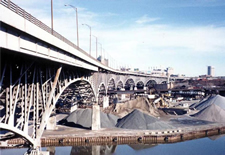|
|
|
|
Introduction - The capital improvements section
identifies specific recommendations for maintaining and improving
Cleveland’s transportation and transit infrastructure. A
well functioning transportation system is vital to the economic
vitality of the City. The type and location of these capital expenditures
will also have a direct impact on the future pattern of land use,
investment and development. In addition to maintaining the condition
of the existing infrastructure, the City of Cleveland also faces
issues related to improving business access to highways, providing
improved public transit options and increasing the number of safe
and attractive opportunities for non-motorized transportation. |
|
 |
Goals - Major goals addressed in Citywide Plan’s
list of capital improvement recommendations include:
Transportation:
- Improvement of the innerbelt freeway, the innerbelt bridge and its
approaches
- Developing stronger connections to Lake Erie
- Creating better north-south movements through the Cuyahoga Valley
- Extending the Towpath Trail to Downtown and connecting it to the
neighborhoods
- Connecting the east side and University Circle better to the freeway
system
- Upgrading the condition of a variety of existing roads, bridges
and streetscapes.
Transit:
- Strengthening the corridor between Downtown and Euclid Avenue ,
two of the City’s major employment centers
- Improving transit-oriented development opportunities
- Expand rapid transit opportunities to more neighborhoods
- Accommodating inter-city rail transportation
A more complete description of issues and strategies can be found in the
citywide Transportation Chapter of the Full Text Document . Transportation
issues related to each Planning District are addressed in each of the District
Chapters, also located within the Full Text Document.
Funding Capital Improvements – Capital improvements
are funded through a combination of local, state and federal monies. The
City of Cleveland generally provides local funds through the issuance of
general obligation bonds. The bonds provide upfront pots of money for large
projects and are repaid over a number of years with local tax dollars. Most
large projects are undertaken with funds obtained from a variety of state
and federal programs. The general obligation bonds provide the local share
of projects costs that state and federal programs require. Some community
development projects, such as the infrastructure improvements necessary
to build a new housing proposal, are financed with 100 percent City money.
How local capital improvement monies are allocated is determined by the
City’s administration with approval from City Council.
|



